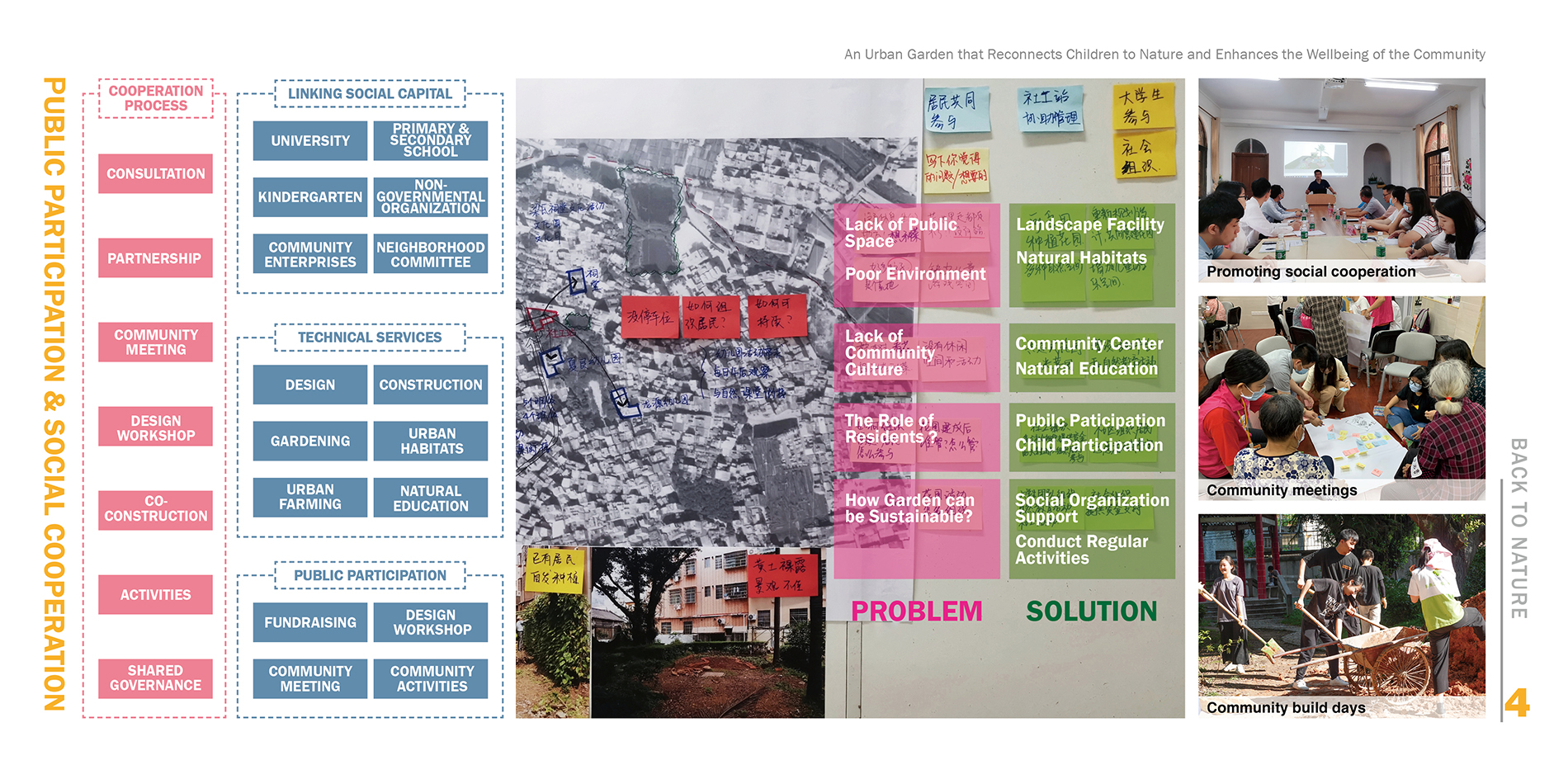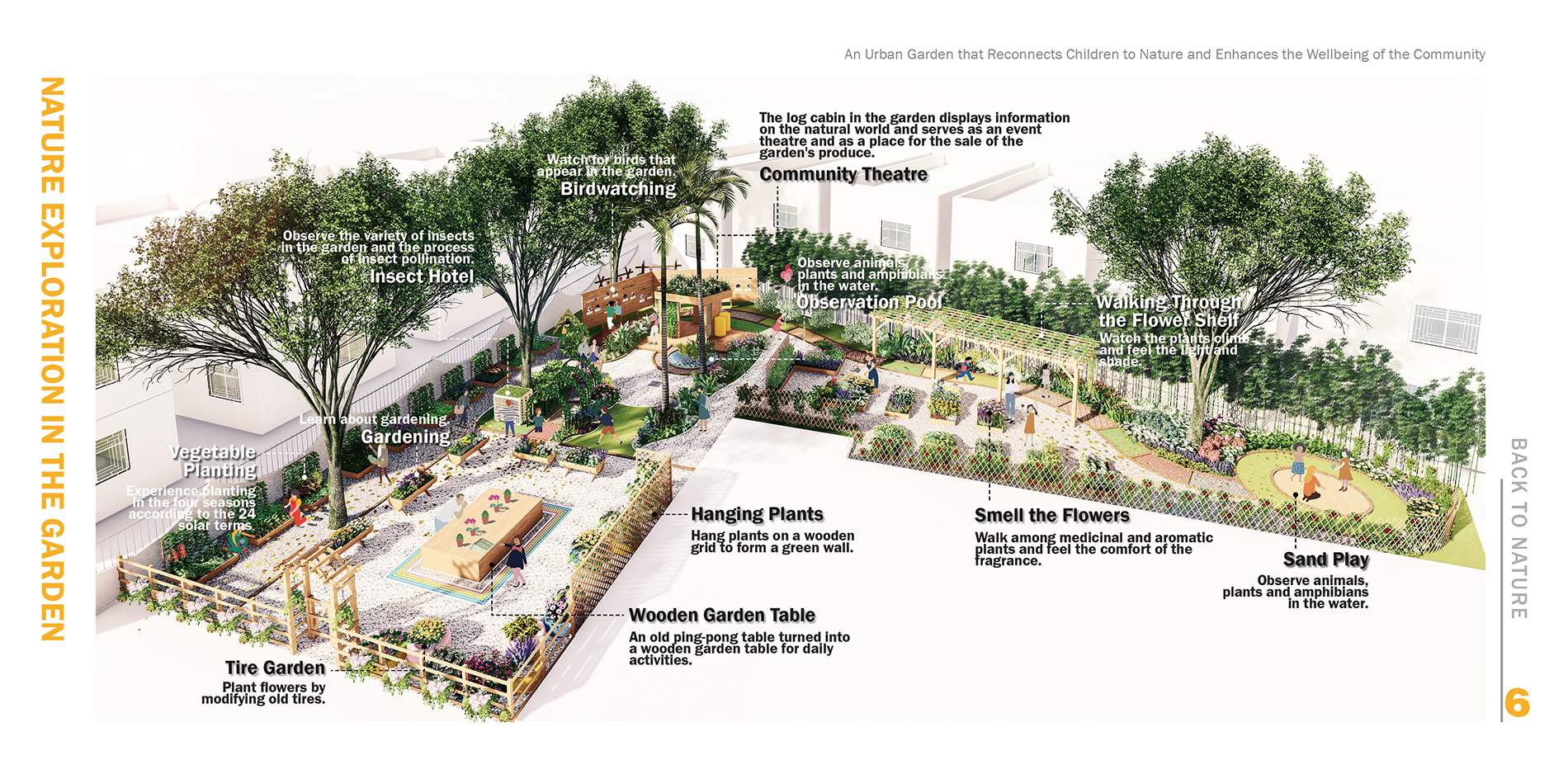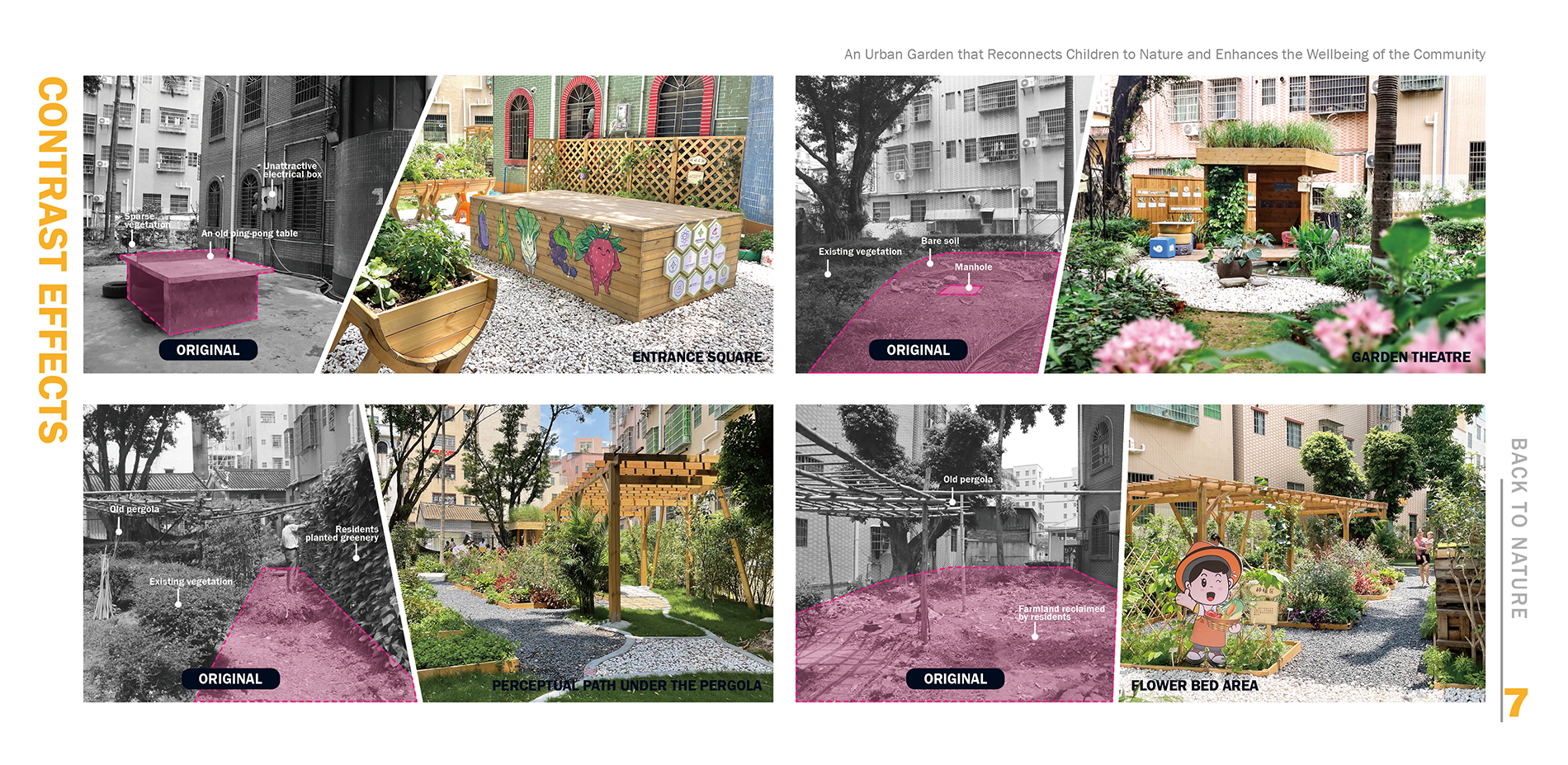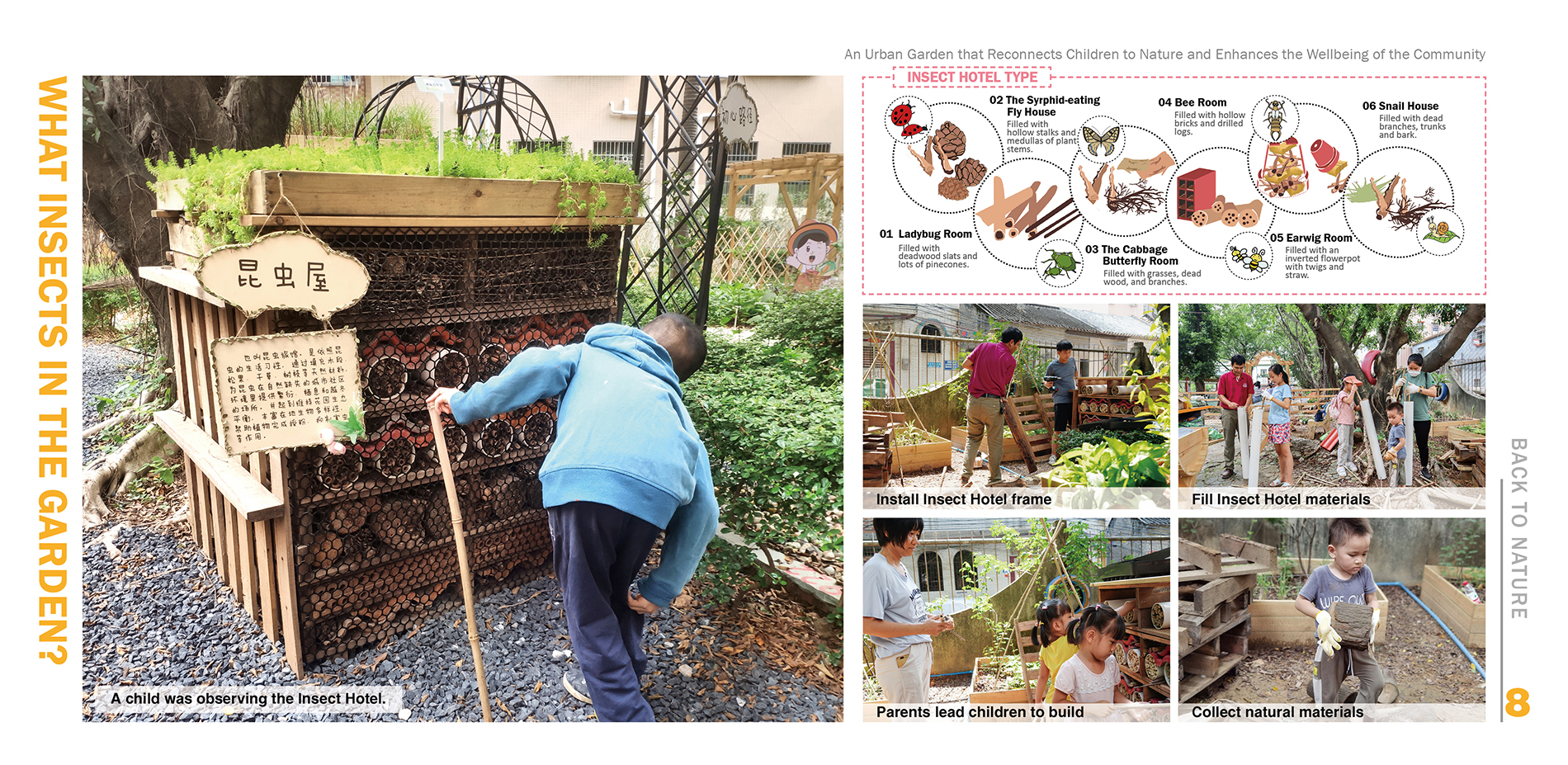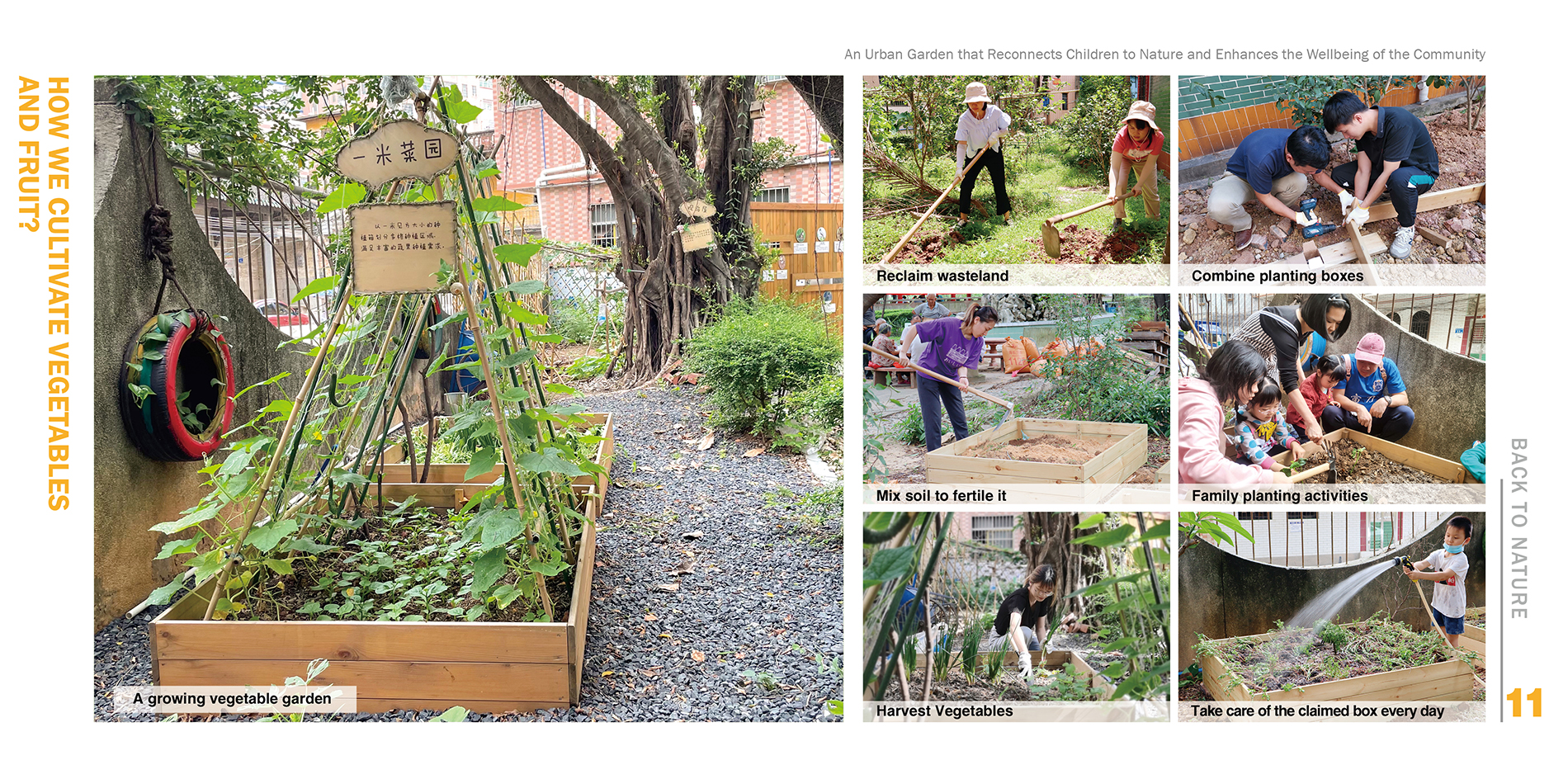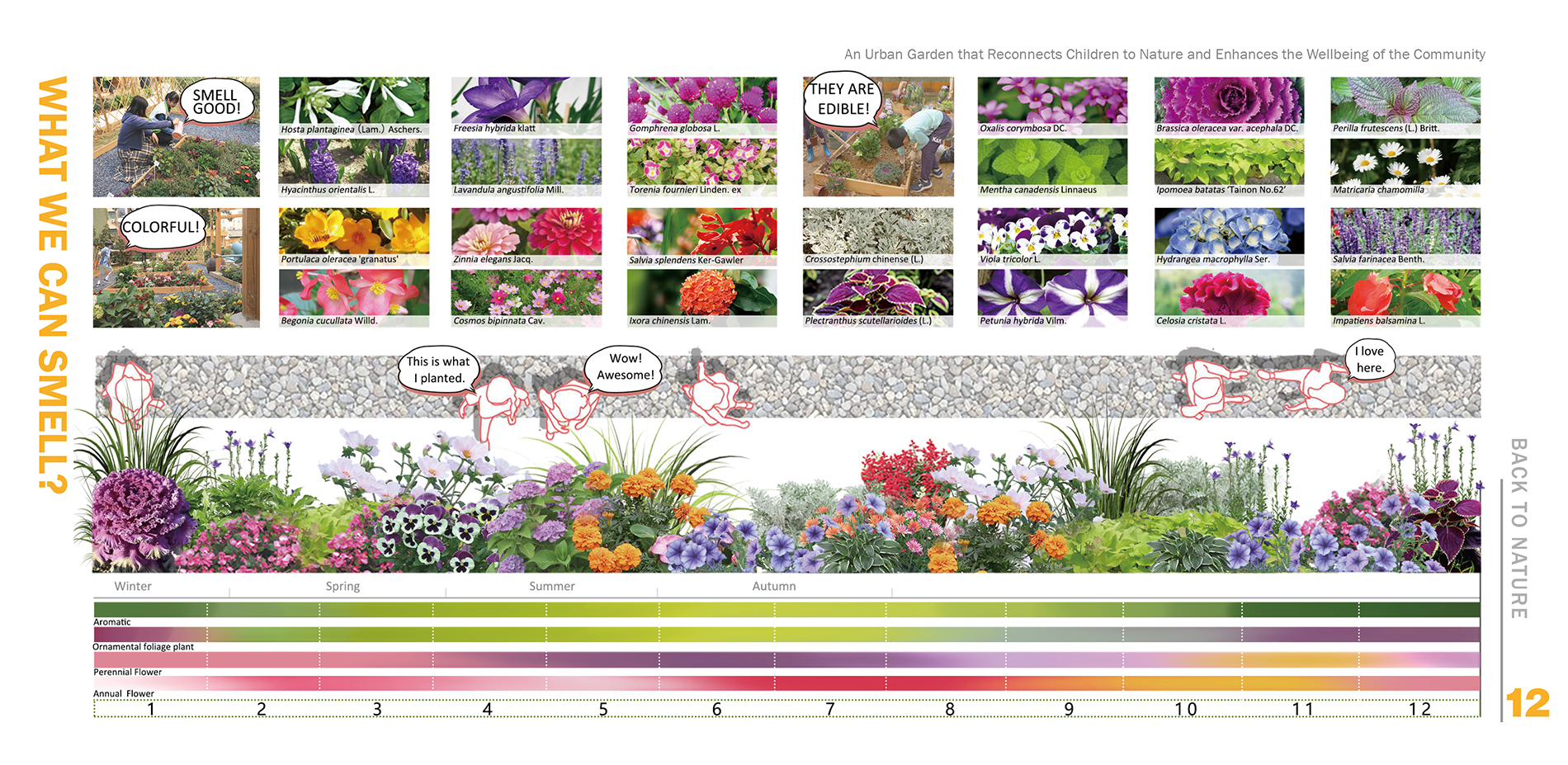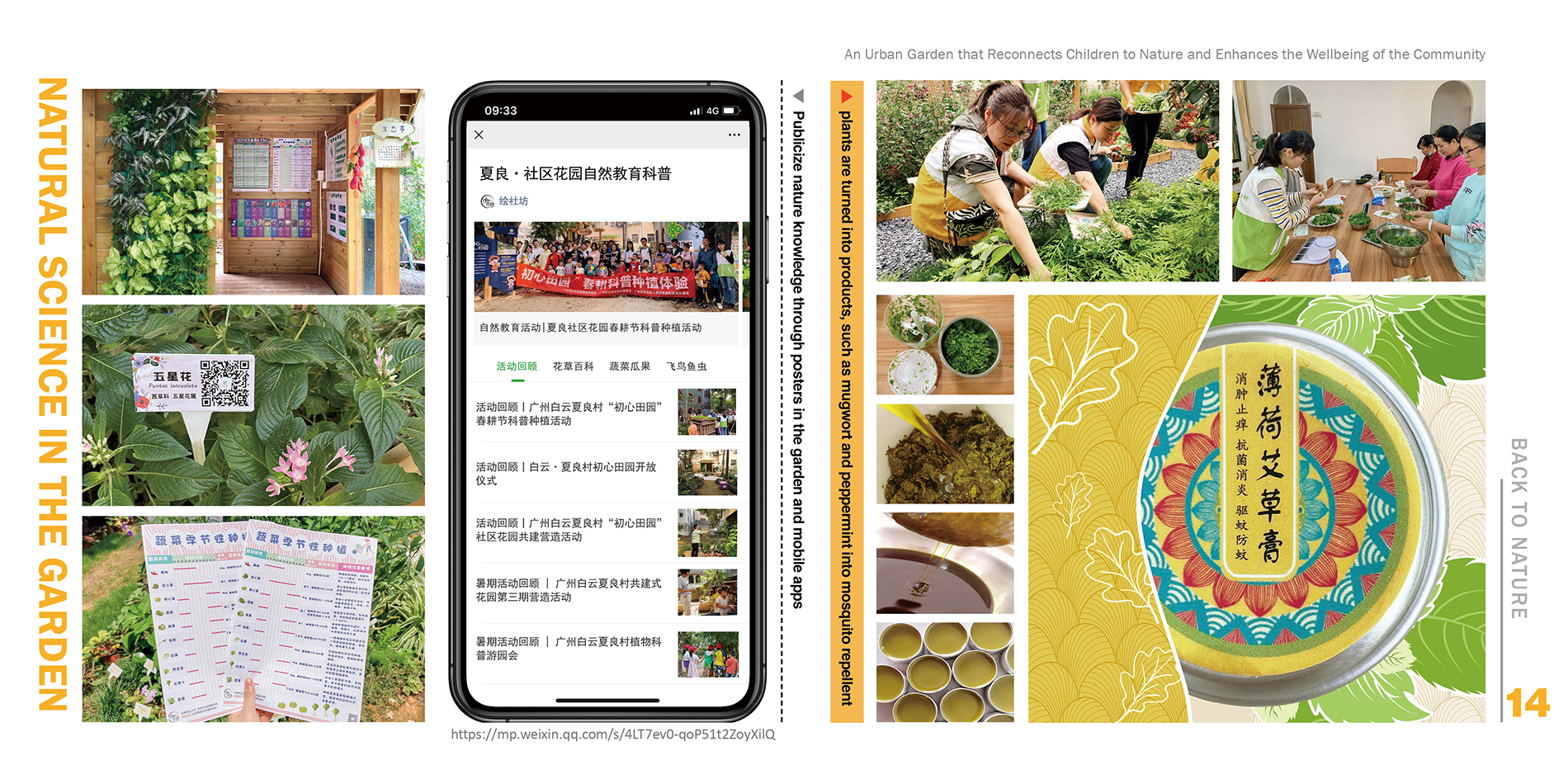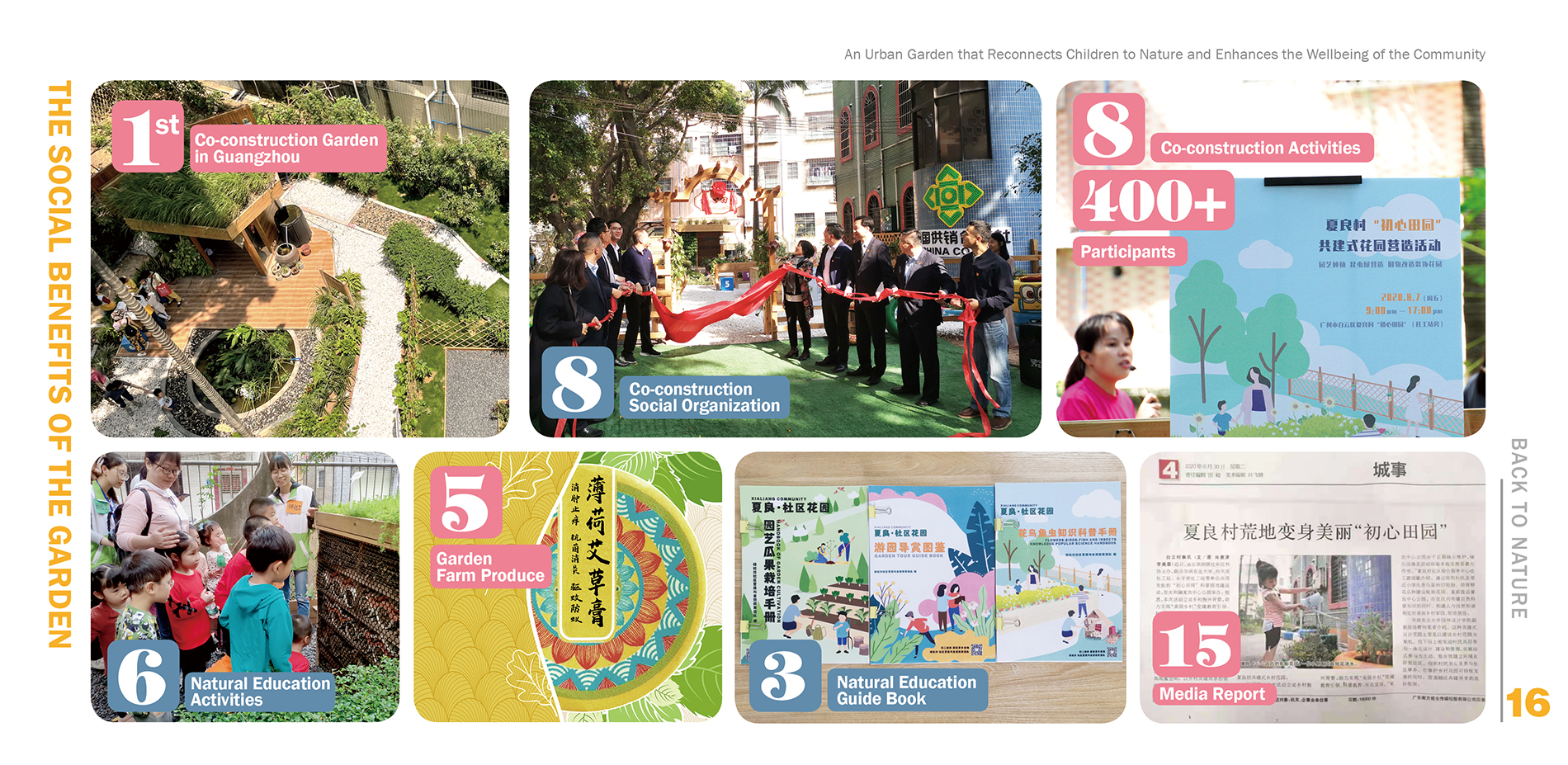Back to Nature: An Urban Garden that Reconnects Children to Nature and Enhances the Wellbeing of the Community
Honor Award
Student Community Service Award
Guangzhou, Guangdon Province, China
Siyi Feng; Beibei Tao; Zhijun Liu, Student International ASLA; Wanshi Huang; Jiaqi Shi; Jiamei Zhao; Muhua Chen; Junying Feng; Haohua Li; Hongyan Liu; Wenqi Wen; Xieqi Xuan; Jiangtao Li; Zhiming Liu; Zexuan Lin; Zishang Huang; Lu Lu; Jieyu Rao
Faculty Advisors: Hui Tang
South China Agricultural University
Back to Nature addressed the diminishing access to nature that results from urbanization. The project focuses on how children in China can receive the benefits of an outdoor education within a larger community framework. The program encourages children to help build the greenspace framework and use ingredients from nature to create products. It also engages parents and adults through digital programming. Each element is well-documented and represented simply and clearly.
- 2021 Awards Jury
Project Statement
With increased high-density urban development, public space in old communities is becoming increasingly compressed, and nature-deficit disorder in children is increasing. Little or no time in the natural environment can lead to physical and mental problems, including anxiety and distraction. The Back to Nature project is based on children’s natural education. Through micro-transformation and public participation, the team and residents co-constructed a community garden that helps people connect with nature, learn, improve physical and mental health, and socialize with others. Children can be happy and relaxed here. This garden can enhance people’s environmental awareness and promote a sense of community cohesion.
Project Narrative
Background
Because of the improper management and shortage of land use in old urban communities, there are some serious problems, such as a shortage of green space per capita, few opportunities for residents to engage in outdoor activities, a lack of understanding of their community and indifferent neighborhood relations. As a result of the two-child policy, the number of children continues to increase. Community public spaces need to be developed to enable children to connect with nature, learn, communicate with others and connect with their families and communities.
The site is located next to the community service center of Xialiang Community, Baiyun District, Guangzhou City, Guangdong Province. The per capita green area in this community is far below the average level, and there is only one green park provided for residents’ daily activities. However, due to the poor quality of the landscape and lack of facilities, the utilization rate is low. According to our team’s preliminary social survey, the population of children under the age of 18 in the community accounts for more than 35%, and the demand for children's outdoor activities is high. The Community Service Center hopes to transform the wastelands into a community public garden, with children as the main users. In April 2019, our team was entrusted to start this project. It is hoped that the garden will develop into an activity venue that cares for children, connects residents and enhances community cohesion.
Design Concept
We aimed to restore a sense of community by establishing a natural habitat. We have constructed a garden in cooperation with residents. We have introduced social organization support to form social capital. With natural education as the driving force, a complementary mechanism of effective activation of space and sustainable development should be formed to guide residents to participate in this community garden and let them get back to nature. Through learning about nature and the place they live in, the garden can foster children’s ecological awareness, sense of locality and sense of belonging.
Site Activation Strategy: Public Participation
Residents are encouraged to organize themselves and participate actively. Neighborhood barriers are gradually broken down and a sense of belonging to the community is generated through joint participation. By introducing NGO funding, residents’ meetings, participatory design, joint construction and joint governance, a social network is formed and the site is activated while the community is cultivated.
Site Sustainability Strategy: Natural Education
The garden applies some design concept and elements, including plant beds, an edible plant landscape, a healing plant landscape, sensory areas, rainfall collection and utilization and reuse of old objects garden habitats and so on. Parents and children are guided to actively engage in natural activities to increase their awareness and respect for the natural environment.
Design Elements
(1)Biological Habitat
There are two biological habitats: the Insect Hotel and the birdwatching garden. The Insect Hotel is an installation built according to the habits of six kinds of insect, such as ladybugs, syrphid-eating flies and imported cabbageworm, and attracts insects to stay in the garden, facilitating the ecological balance of the garden, helping plants complete pollination and inhibiting pests. The birdwatching garden is planted with bird-guiding plants and has areas with grain to attract birds. The wooden board with the observation window is separated from the activity area to achieve a harmonious coexistence between people and nature.
(2)Rainwater Collection System
The roof of the garden cabin guides rainwater to the filter bucket and the water storage bucket. The filtered rainwater is used for roof greening and vertical greening irrigation. The excess rainwater is discharged into the pool. How the rainwater is collected and utilized is shown through the arrangement of the pipes.
(3)Ecological Pond
A natural ecological pond, self-purifying through aquatic plants, provides a place to observe aquatic plants and amphibians.
(4)Edible Plant Landscape
There are 10 1m*1m vegetable and fruit planting boxes in the garden. The planting boxes are divided into multiple planting areas to meet rich vegetable and fruit planting needs. These boxes are taken care of by families in the community, who can decide what to grow and learn growing techniques in the garden.
(5)Multisensory Experience
This includes planting flowers and plants of various colors, aromatic plants, and medicinal plants beneficial to the body and mind, providing a sensory experience. There are also perceptual paths filled with a variety of natural materials allowing the visitor to feel different textures
(6)Garden Theatre
The cabin covers an area of five square meters. It is decorated with information about the activities of the garden and natural education. It serves as a multi-functional stage to hold various community activities and sell agricultural products from the garden.
Natural Education Activities
(1)Natural Science in the Garden
Seasonal planting posters are posted in the garden cabin, and pamphlets are distributed regularly to popularize horticulture techniques. In addition, to assist children, residents, and visitors to learn from nature observation, information is posted at observation points, such as the plant beds, bird-watching gardens, and insect houses.
(2)Regular Nature Classes
The team regularly carries out natural education activities in the community garden to teach children about natural world disciplines, such as botany, ecology, environmental issues, land ethics, etc.
(3)Garden Production
Cooperating with social workers, the team leads residents to use the flowers and plants in the garden to make various agricultural products for sale, such as using mugwort and mint to make mosquito repellent ointment, aromatic flowers for aromatherapy, etc.
Cooperation Process
The site belongs to the attached green space of the community service center. In April 2019, the center commissioned the team to begin preparations for the construction of the garden. The project team consists of 18 students majoring in landscape architecture. Since June, many social organizations have been invited to invest funds and provide materials for the garden to revitalize the community capital. In July, with the help of community workers, the team organized a Residents' Committee to discuss the construction of the garden. From August to December, residents were asked to design and build gardens through design workshops and Community Build Days. In January 2021, the garden was formally completed and put into use. The garden is jointly managed by the community service center and the residents. The residents have formed a volunteer team to regularly maintain the garden and prune the plants. After the garden was completed, the student team went to the garden every month to conduct nature education activities. So far, under the leadership of the team, residents have been deeply involved in the design, construction, and management of the garden. In addition, various entertainment, educational and social activities have been held in the garden, which has become a natural place for children and residents to relax, communicate and interact.
Social Benefits of the Garden
The successful completion of the garden was supported by eight cooperative units, through eight joint construction activities in four months, with more than 400 community volunteers. Since the completion of the garden, we have carried out nature education activities once a month. We have produced five kinds of garden farm product and developed three sets of nature education guide manuals for the garden. The garden has received widespread attention from the community, and its high usage rate and popularity have made it a model of micro-renovation for the local community.
Plant List:
- Liriope spicata (Thunb.) Lour.(Latin names)
- Begonia cucullata Willd.(Latin names)
- Peperomia obtusifolia(Latin names)
- Crossostephium chinense (L.) Makino(Latin names)
- mpatiens balsamina L.(Latin names)
- mint
- tuber fern
- Sansevieria trifasciata Prain(Latin names)
- Asparagus densiflorus 'Myers'(Latin names)
- jade hairpin
- hydrangea
- chlorophytum
- Ruellia brittoniana Leonard(Latin names)
- arrowroot
- Rohdea japonica
- spathiphyllum kochii(Latin names)
- Chinese cymbidium
- asparagus fern
- red sage
- Codiaeum variegatum (L.) A. Juss.(Latin names)
- Excoecaria cochinchinensis Lour.(Latin names)
- Ixora chinensis Lam.(Latin names)
- Reineckea carnea var.variegata(Latin names)
- adiantum
- Davallia mariesii Moore ex Bak.(Latin names)
- Podocarpus macrophyllus Don.(Latin names)
- schefflera
- Monochoria hastata Solms(Latin names)
- Setaria viridis (L.) Beauv.(Latin names)
- water lily
- rush
- canna
- Cyperus involucratus Rottboll(Latin names)
- Quisqualis indica L.(Latin names)
- Helichrysum bracteatum (Vent.) Andr. (Latin names)
- Oxalis triangularis subsp. Papilionacea Lourteig(Latin names)
- Zephyranthes candida Herb.(Latin names)
- Gypsophila paniculata L.(Latin names)
- aloe
- Viola tricolor L.(Latin names)



